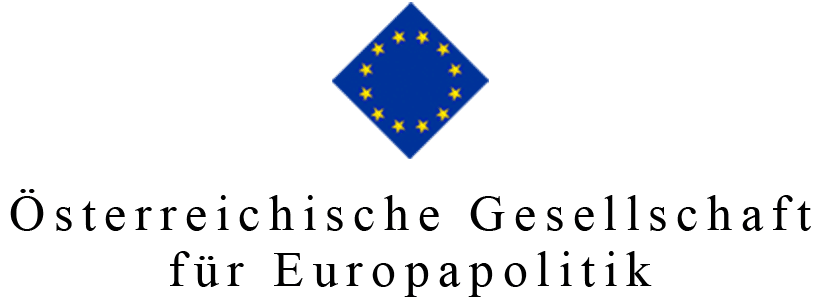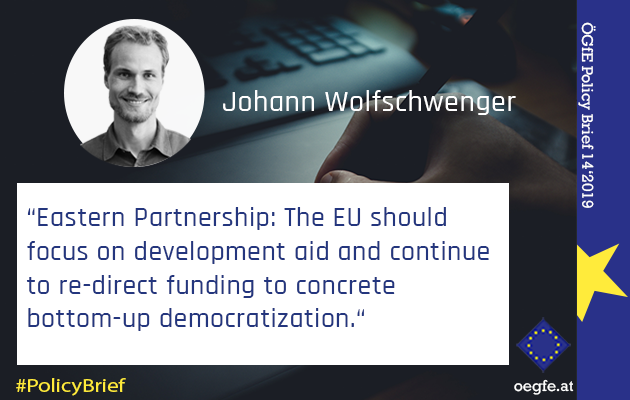Policy Recommendations
- The EU should focus on development aid and continue to re-direct funding to concrete bottom-up democratization.
- The Eastern Partnership should be assessed from a holistic perspective, starting with the repercussions stemming from an instable regional security architecture.
- Austria and like-minded states should promote a new strategic vision for the Eastern neighbourhood – a vision that aims at emancipating the region from Russia and the EU.
Abstract
10 years after the launch of the Eastern Partnership (EaP), the EU finds itself in a strategic dilemma: On the one hand the ‘European aspirations’ of many of the Eastern partners are the driving force behind their domestic democratic reform process; on the other hand, the very same European course nurtures a climate of geopolitical instability in which a democratic transformation and subsequently EU integration seems hardly possible. It has become obvious that the Kremlin’s policy responses are a significant factor to determine the outcome of EU policies in the neighbourhood. Moreover, the EU is internally divided over the future course of the EaP and the relations with Russia. The loophole to resolve this strategic dilemma is understanding the EaP in its entire complexity as an interplay of geopolitics and domestic politics.
****************************
10 Years Eastern Partnership – The EU and its Strategic Dilemma
Introduction
On 7 May 2009 the Eastern Partnership (EaP) was launched under the umbrella of the European Neighbourhood Policy (ENP).[1] The main idea behind the EaP is to allow for a better differentiation between the Southern neighbourhood (including mainly North African states) and the Eastern neighbourhood, including Armenia, Azerbaijan, Belarus, Georgia, Moldova and Ukraine. The ENP’s and the EaP’s aims are hardly novel, but stem from the EU enlargement process: accelerating political association of the partner states (by, for example, concluding Association Agreements), fostering economic integration and socio-economic and democratic reforms. In doing so, the EU sought to contribute to a prosper, stable and democratic ‘ring of friends’ around its borders.[2] However, 10 years after the launch of the EaP some partner states experience democratic setbacks, suffer from protracted reform processes and Russia’s aggressive geopolitical interventions. Which lessons can be learned from 10 years Eastern Partnership and what is the way forward?
10 years after the launch of the EaP some partner states experience democratic setbacks, suffer from protracted reform processes and Russia’s aggressive geopolitical interventions.
The EaP’s institutional design
The EaP unfolds on a bilateral track and a multilateral track. Bilaterally, each country opts for a different degree of political association with the EU. The frontrunners are Moldova, Ukraine and Georgia which have signed an Association Agreement (AA) and a Deep and Comprehensive Free Trade Agreement (DCFTA) with the EU in 2014. These agreements represent heavy-burdening governance packages through which a significant part of the EU’s acquis communautaire[3] is adopted by the partner countries.[4] Relations with Armenia and Azerbaijan are governed by less ambitious agreements. While in the case of Azerbaijan a Partnership and Cooperation Agreement (PCA) from 1999 is in place, Armenia opted for a middle-way signing a Comprehensive and Enhanced Partnership Agreement (CEPA) in 2017. The bilateral track guides a domestic reform agenda on the basis of those agreements. It operates mainly through incentives for incumbent political elites and capacity building in public administration and civil society.
The multilateral track aims at fostering links and regional cooperation among partner countries and between them and the EU member states. Unlike the bilateral track, the multilateral track is more politicized and usually produces rather declarations of intend than incentive-based action plans. The main fora are the bi-annual EaP summits in which the heads of governments of EU member states and partner states convene.[5]
The 2015 EaP Review and the EU Global Strategy from 2016 downgraded the EaP from its originally transformative ambition to a pragmatic and interest-based approach.
While the wording of the EaP’s early documents leaves room to imply a distant membership perspective[6], recent documents suggest the current ‘Partnership’ or the Association Agreement to be the interim finalité.[7] Furthermore, the 2015 EaP Review[8] and the EU Global Strategy from 2016[9] downgraded the EaP from its originally transformative ambition to a pragmatic and interest-based approach.[10] Especially the Netherlands and Germany turned increasingly sceptic towards continued EU integration; other EU member states, like Romania, Poland, Sweden and the Baltic States as well as the European Parliament have advocated stronger EU engagement.[11] Member states like France, Spain, and Italy are more or less ambivalent towards the EaP, as their focus lies on the southern dimension of the ENP. As an allegedly Russia-friendly country, Austria has played a similar ambivalent role and neither championed nor blocked the EaP at any level (Wolfschwenger 2018). In 2016 Austria opened Embassies in Moldova and Georgia. Austria’s political strategies focus on relatively strong development aid, strengthening economic relations, and the promotion of a ‘model of neutrality’ as a response to the geopolitical tensions in the region.[12]
Lessons learned from 10 years EaP
Democratic transformation or democratic backsliding?
Democratic and socio-economic reform processes in EaP states have experienced ups and downs over the past 10 years. Moldova, which has been hailed front-runner of EU integration before 2014, has probably experienced the gravest setback in terms of democratic standards.[13] In 2014, the pro-European reform coalition became entangled in a massive corruption scandal in which more than 1 billion dollar (roughly 15 percent of Moldova’s GDP) was embezzled from three of the largest Moldovan banks. Since then the Democratic Party, chaired by Oligarch and media tycoon Vladimir Plahotniuc, has managed to establish firm grip over Moldova’s politics and keeps challenging judicial independence. Similarly, in Georgia, billionaire Bidzina Ivanishvili pulls the strings from behind the ruling party Georgian Dream after a relatively reform-intense period under President Micheil Saakashvili. Holding no governmental office, Ivanishvili and Plahotniuc act outside democratic control and institutional checks and balances. They rely on shadowy informal power structures stemming from their wealth. Ukraine (2014) and Armenia (2018) experienced mass protests that led to governmental changes. However, in Ukraine Petro Poroshenko’s term was rather dominated by geopolitical issues than by a substantial fight against Oligarchy. The victory of the polit-novice Volodymyr Zelensky in Ukraine’s 2019 presidential elections is a sign of people’s prevailing dissatisfaction with the oligarchic establishment. A more promising (but indeed not ‘pro-European’) change of incumbents has taken place in Armenia in 2018, where protests led by Nikol Paschinjan ousted President Sersch Sargasjan.
In terms of democratic transition the EU’s institution-building instruments, footed on capacity-building and acquis transfer, have proven inefficient against oligarchic political practices in partner states.
In terms of democratic transition the EU’s institution-building instruments, footed on capacity-building and acquis transfer, have proven inefficient against oligarchic political practices in partner states. Case-based ex-post assessments of EU assistance find that factors like the lack of absorption capacity on the side of the partner states, the rigid design of support programs which does not allow for adjustment to local circumstances, or simply institutional ineffectiveness on the side of the donors contribute to the lack of efficiency of EU instruments (Wolczuk 2019, Leitch 2017). Furthermore, in some cases (e.g. Moldova) the EaP has unintentionally empowered illiberal incumbent elites as they could instrumentalize EU support and use it as a cover-up for rent-seeking political practices (Dandashly and Noutcheva 2019). At the same time, in many countries the civil society sector, funded almost entirely by Western donors, is the ultimate bulwark against further autocratic tendencies. Noticing its own inefficiency and potential unintended consequences, the EU substantially downscaled budget support programs as a result of inefficiency (i.e. Ukraine) or put them on hold as a result of democratic backsliding (i.e. Moldova). Instead the EU has increasingly focused on civil society support, economic development, and infrastructure and development projects.
The EaP and geopolitics
In the course of the past 10 years, the EU’s own integration agenda became challenged by Russia’s antagonistic integration project. This has three consequences: First, it became clear that the Kremlin’s policies matter to determine the outcome of EU policies on the ground (Delcour 2017). Russia possesses the power to stir instability in EaP countries by spreading disinformation or promoting the Russian world view or to ‘punish’ partner state’s foreign policy choices by trade-related sanctions. Second, over many years, the EU pursued a policy that aimed at exporting the EU’s system of governance to a region which the Kremlin regarded as its own backyard. In doing so, the EaP contributed to a deterioration of EU-Russia relations, as it undermined the EU’s credibility as strategic partner from a Russian perspective (Casier 2019). Third, besides Russia’s direct responses, geopolitics has captured domestic political discourses in many partner countries. On a domestic level ‘pro-EU reformers’ stand against a camp of EU-sceptics that are supporting a balanced foreign policy orientation between the East and the West (e.g. President Igor Dodon in Moldova and formerly President Viktor Yanukovych in Ukraine). The resulting polarization of domestic discourses may not only weaken social cohesion in the partner states (cf. Groza et al. 2018) but also be beneficial for oligarchs as they can distract from their corrupt practices (cf. the concept of ‘stablitocracies’ specified by the Balkans in Europe Policy Advisory Group 2017).
However, the EaP’s institutional design is inherited from the EU enlargement process in which geopolitics did not play a role at all. It is therefore ill-equipped to operate in a geopolitical context.
Although unintended on the EU’s part, the EaP has gained enormous geopolitical significance in the foreign policy making of partner countries, third states like Russia, and above all the EU itself.[14] However, the EaP’s institutional design is inherited from the EU enlargement process in which geopolitics did not play a role at all. It is therefore ill-equipped to operate in a geopolitical context. The cost-benefit logic by partner states, which is presupposed by conditionality, is taken ad-absurdum if partner states foreign policy decisions (e.g. signing the AA and DCFTA) are guided by geopolitical thought. Moreover EU strategic documents neither engage with potential repercussions from Russia’s reactions, nor do they consider potential consequences for EU-Russia relations. Hence, through the lens of a holistic perspective, the assumption that the EaP is a bilateral issue between the EU and the partner states has become a major obstacle for the effectiveness of the EaP and stands in contradiction to the EU’s primary goal of fostering political stability and democracy in its Eastern neighbourhood.
A new vision for the neighbourhood
The limited performance in terms of democratic and socio-economic transition stands against the geopolitical dimension of the EaP which has massively gained importance in the past 10 years. As a consequence, the EU has manoeuvred itself and its Eastern partners in a strategic dilemma: on the one hand, the ‘European aspirations’ of EaP states are the driving force behind a democratic reform process, while at the same time the very same European aspirations have resulted in geopolitical tensions and political instability in which the necessary reform process is unlikely to take place. Understanding this strategic dilemma in its entire complexity and with all its feedback loops is the challenge of future EaP policy making. Together with the partner countries a new vision for the neighbourhood should be developed – a vision in which the Eastern neighbours are neither appendage to the EU, nor left alone with Russia’s aggressive practices but aims to emancipate the region from geopolitical influences. This is all the harder since the EU itself is fundamentally divided over how to deal with Russia (hardliner versus ‘Putinversteher’) and as the EU itself undergoes a phase of ‘consolidation’ (i.e. Brexit and the rise of Eurosceptic actors within the EU).
Recommendations
10 years after its launch, the EaP should ultimately shake off the legacy of enlargement and unequivocally turn into a foreign-policy instrument.
The EU should stop overlooking that Russia’s reaction to the EaP is a relevant determinant for its outcomes. Instead, the EU should start assessing the EaP from a holistic perspective, starting with the role of the instable regional security architecture. As a first step, respective wording should enter the EU’s strategic documents (e.g. EaP summit declarations). As a potential second step, the architecture of the EaP’s multilateral track[15] could be expanded by a security pillar which serves as a forum of exchange on this issue.
Conditionality, top-down institution-building (i.e. budget support programs) and heavy-burdening rule-transfer agreements (i.e. the AA and the DCFTA) are ill-equipped tools to foster democratic and economic reforms in a context of political instability. Instead, the EU should focus on development aid and continue to re-direct funding into concrete bottom-up democratization, infrastructure and social projects.
10 years after its launch, the EaP should ultimately shake off the legacy of enlargement and unequivocally turn into a foreign-policy instrument. On a broad societal level the EU and the partner states should develop a new strategic vision for the neighbourhood. Such a vision follows an emancipatory approach and turns the alleged weakness – the region’s in-betweenness – into strength.
Austria’s promotion of neutrality as a model for partner states is a meaningful contribution to such a debate. Austria and like-minded states should continue turning this into a strategic position on an EU level and bilaterally with EaP countries.
Acknowledgments
This Policy Brief has been produced in the framework of the GEM-STONES project funded by the Marie Skłodowska-Curie Grant Agreement No 722826. Its arguments have been presented and discussed in various conferences and public events.
[1] See https://www.consilium.europa.eu/media/31797/2009_eap_declaration.pdf
[2] See http://eeas.europa.eu/archives/docs/enp/pdf/pdf/com03_104_en.pdf
[3] For further information see http://en.euabc.com/word/12
[4] For a detailed overview of the Association Agreements and the state of implementation see (Emerson 2018c, Emerson 2018a, Emerson 2018b)
[5] Because of EU parliamentary elections and Brexit no EaP summit is foreseen this year. However, a high level conference took place in Brussels on 14 May on the occasion of the 10th anniversary of the EaP.
[6] Unlike in the Balkans an explicit membership perspective has not been granted to EaP countries.
[7] See the Joint Declaration of the most recent EaP Summit in 2017: https://www.consilium.europa.eu/media/31758/final-statement-st14821en17.pdf, Art 10
[8] See http://eeas.europa.eu/archives/docs/enp/documents/2015/151118_joint-communication_review-of-the-enp_en.pdf
[9] See http://eeas.europa.eu/archives/docs/top_stories/pdf/eugs_review_web.pdf, pp. 25-26
[10] The new approach emphasizes political stability and the EU’s security interests instead of broad democratic transformation of the EaP countries.
[11] https://www.rferl.org/a/eu-summit-georgia-moldova-ukraine-eastern-partership/28749474.html
[12] Author’s talks with the Austrian Ambassadors in Georgia and Moldova in 2018 and 2019.
[13] See http://www.europarl.europa.eu/doceo/document/TA-8-2018-0458_EN.pdf, Art 3
[14] Strengthening relations with the Eastern partners is one of the five guiding principles of the EU’s policies towards Russia. See https://eeas.europa.eu/headquarters/headquarters-homepage/5490/remarks-by-high-representativevice-president-federica-mogherini-at-the-press-conference-following-the-foreign-affairs-council_en
[15] See https://eeas.europa.eu/sites/eeas/files/swd_2017_300_f1_joint_staff_working_paper_en_v5_p1_940530.pdf, p. 50
- Balkans in Europe Policy Advisory Group, BiEPAG. 2017. The Crisis of Democracy in the Western Balkans. Authoritarianism and EU Stabilitocracy. http://www.biepag.eu/publications/the-crisis-of-democracy-in-the-western-balkans-authoritarianism-and-eu-stabilitocracy.
- Casier, Tom. 2019. The Unintended Consequences of a European Neighbourhood Policy without Russia. The International Spectator 54 (1):76-88.
- Dandashly, Assem, and Gergana Noutcheva. 2019. Unintended Consequences of EU Democracy Support in the European Neighbourhood. The International Spectator 54 (1):105-120.
- Delcour, Laure. 2017. The EU and Russia in Their ‘Contested Neighbouhood’. Multiple External Influences, Policy Transfer and Domestic Change. Abingdon: Routledge.
- Emerson, Michael; Cenusa, Denis. 2018a. Deepening EU-Moldovan Relations. Second Edition. London: Rowman & Littlefield International.
- Emerson, Michael; Kovziridze, Tamara. 2018b. Deepening EU-Georgian Relations. Second Edition. London: Rowman & Littlefield.
- Emerson, Michael; Movchan, Veronika. 2018c. Deepening EU-Ukrainian Relations. Second Edition. London: Rowman & Littlefield.
- Groza, Iulian, Mathias Jopp, Vladislav Kulminski, Vadim Pistrinciuc, Andrei Popov, Adrian Popescu, and Julian Rusu. 2018. Strenghening Social Cohesion and Common Identity in the Republic of Moldova. http://iep-berlin.de/wp-content/uploads/2018/02/Social-Cohesion-and-Common-Identity-EN.pdf.
- Leitch, Duncan. 2017. Leaving like an Englishman: Assisting institutional reform in post‐communist Ukraine. Development Policy Review 37 (1):111-128.
- Wolczuk, Kataryna; Zerulois, Darius. 2019. Fit for Purpose? Evaluating the EU’s Assistance to Ukraine. EU-STRAT Policy Brief Series 5.
- Wolfschwenger, Johann. 2018. Georgia in European Discourses: An Austrian Perspective. Georgian Institute of Politics, Policy Memo 27. http://gip.ge/georgia-european-discourses-austrian-perspective-2.
ISSN 2305-2635
The views expressed in this publication are those of the author and not necessarily those of the Austrian Society of European Politics or the organisation for which the author is working.
Citation
Wolfschwenger, J. (2019). 10 Years Eastern Partnership – The EU and its Strategic Dilemma. Vienna. ÖGfE Policy Brief, 14’2019







